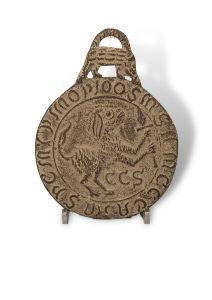The Shadwell Forgeries
(Or: How Two Illiterate Mudlarks Fooled Victorian Academics and Archaeologists)

During the middle of the 19th century, the south of England’s antiquarian market was inundated by a huge number of lead objects including medieval-looking medallions, statues, amulets and coins that came with absolutely no provenance. Of course, some academics and archaeologists raised concerns about their authenticity, but it was a case of the emperor’s new clothes – no one wanted to be the one to say they weren’t real. So, the consensus was that this questionable collection of primitive, badly spelled, childishly drawn and down-right weird bunch of items was accepted into the museum world.
The objects were eventually revealed to be forgeries made by two Thames mudlarks, William Smith (Billy) and Charles Eaton (Charley). It dawned on them that they could earn more money by making and selling antiquities themselves. William Edwards, a London antique dealer, made Billy's acquaintance around 1845, and he met Charley some years later. He paid them for items of interest that they found, thinking of them as "his boys"; an upper-market Fagin.
In 1857, Billy and Charley began making “medieval” objects by making molds out of plaster of Paris and then rudely casting the objects in lead and alloy before treating them with acid and coating them with river mud. Besides the terrible cartoon-like figures and animals, the inscriptions on the objects were utterly meaningless too; nothing but scribbles. Neither Billy nor Charley could spell.
The dates (they had given them dates between the 11th and 16th centuries) weren’t even authentically written. The pair had used Arabic numbers even though they weren’t used in Europe until the 15th century.
All these glaring mistakes passed inspection by historians without anyone raising a beetling, stuffy eyebrow. What’s embarrassing in hindsight was how readily some of the most authoritative of Victorian London’s antiquarians, academics and archaeologists fell for the questionable workmanship and, if nothing else, the sheer quantity of these previously unknown objects!
Billy and Charley produced between 5,000 and 10,000 forgeries until they were finally rumbled. In 1867, while trying to sell some of the forged items, a clergyman recognised the objects as forgeries and alerted the police. Billy and Charley were arrested but the court released them on grounds of insufficient evidence; ironic as their forgeries didn't have any historical evidence either.
Charley Eaton died in January 1870 of tuberculosis. William Smith was last seen in 1871 trying unsuccessfully to sell a lead copy of a 13th century jug. He then disappeared and nothing further is known of him.
Shadwell forgeries can be found in many museum collections and have acquired quite a reputation and a following as being fascinating objects in their own right. These forgeries — known as Billy and Charleys — have become relatively valuable. Viewed primarily as folk art, since they were created by men who weren’t educated or even literate, Shadwell forgeries are often sought after in the art world. Lancaster City Museums own at least a dozen.













